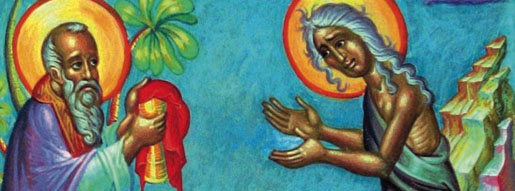Venerable St. Mary of Egypt
Venerable St. Mary of Egypt was born in 344 somewhere in Egypt and at the age of twelve ran away to the city of Alexandria where she lived an extremely dissolute life. According to her words, she was driven only"by an insatiable and an irrepressible passion". After seventeen years of this lifestyle, she travelled to Jerusalem by boat for the Feast of the Exaltation of the Holy Cross. She undertook the journey not for the religious reasons, but stating that she hoped to find in the pilgrim crowds at Jerusalem even more partners in her lust. She paid for her passage by offering her body to other pilgrims, and she continued her habitual lifestyle for a short time in Jerusalem.
During the Feast of the Exaltation of the Holy Cross, she tried to enter the Church of the Holy Sepulchre for the celebration, she was barred from doing so by an unseen force. She tried several more time hopelessly to enter the church, but she realized that this was because of her impurity, she was struck with remorse and cried. Then she saw an icon of the Theotokos (the Virgin Mary) outside the church, so she prayed for forgiveness in a great fear and promised to give up the world (i.e., become an ascetic). Then she attempted again to enter the church, and this time was permitted in. After venerating the relic of the true cross, she returned to the icon of Theotokos to give thanks, and heard a voice telling her, "If you cross the Jordan, you will find glorious rest/ true peace!" She immediately went to the monastery of St. John the Baptist on the bank of the River Jordan, where she received absolution and afterwards Holy Communion. The next morning, she crossed the Jordan and retired to the desert to live the rest of her life as a hermit in penitence. She took with her only three loaves of bread, and once they were gone, lived only on what she could find in the wilderness. So she lived for 47 years, in prayers and struggle with temptations and passionate thoughts.
Approximately one year before her death, she recounted her life to St. Zosimas of Palestine who encountered her in the desert.When he unexpectedly met her in the desert, she was completely naked and almost unrecognizable as human. She asked Zosimas to toss her his mantle to cover herself with, and then she narrated her life's story to him, manifesting marvellous clairvoyance. She asked him to meet her at the banks of the Jordan on Holy Thursday of the following year, and bring her Holy Communion. When he fulfilled her wish, she crossed the river to get to him by walking on the surface of the water and received Holy Communion, telling him to meet her again in the desert the following Lent. The next year, Zosimas travelled to the same spot where he first met her, some twenty day's journey from his monastery, and found her lying there dead. According to an inscription written in the sand next to her head, she had died on the very night (April 1) he had given her Communion and had been somehow miraculously transported to the place he found her, and her body preserved incorrupt. He buried her body with the assistance of a passing lion. On returning to the monastery he related her life story to the brethren, and it was preserved among them as oral tradition until it was written down by St. Sophronius (634-644).
Venerable St. Mary the Egyptian in Orthodox Church is celebrated on April 1, and it is mentioned on fifth week of the Great Lent. The chapel dedicated to St. Mary the Egyptian is located in the church of Holy Sepulchre in Jerusalem.


